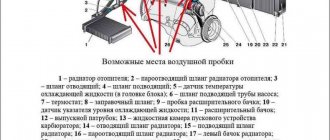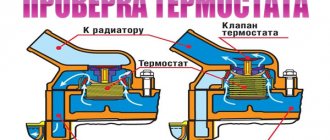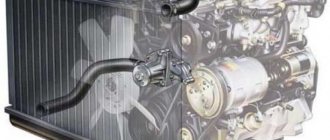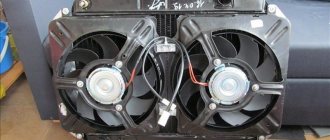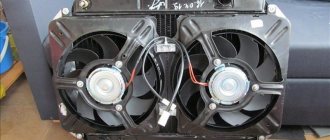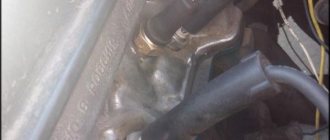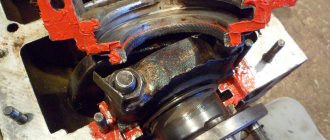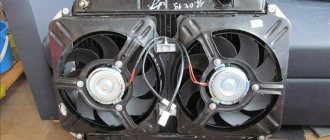A decrease in the efficiency of the interior heater and too rapid warming up of the engine, which develops into overheating, are typical symptoms of air in the engine cooling system. The main reasons for the formation of air locks are insufficient coolant level or depressurization of the system , but there are others.
From this article you can learn what an air lock is, why it occurs and how to quickly bleed air from the engine cooling system.
How to determine engine overheating
The fact that this particular “trouble” occurred can be determined by several signs:
- Either the red indicator lights up on the dashboard, or the temperature gauge rises noticeably. This indicates the motor is heating up;
- The engine is boiling, and the heating air is cold;
- Experienced drivers will immediately determine that there is a fairly large temperature difference in the upper pipe along with the lower one.
The presence of air in the cooling system is not just an annoying nuisance, but a catastrophic fact that many inexperienced drivers simply may not notice or not pay due attention to. The consequences manifest themselves much later, when you have to stop in the most unexpected place, seeing steam escaping from the hood.
Many manufacturing companies, unfortunately, no longer provide temperature indicators with an arrow in their cars. Although sometimes the presence of such is not always able to protect drivers from such problems.
What causes engine overheating?
When the temperature reaches its maximum value, along with the presence of a high level of pressure, a breakdown most often occurs in the intermediate partitions of the propulsion systems and their gaskets.
Not only the cooling system suffers from this, but also the lubrication system, gas distribution system and others.
- Significant overheating temperatures bend the head of the block where the cylinders are located. When overheating, this is the most common malfunction when the head becomes like a propeller.
- The head gasket eventually breaks down, causing coolant or oil to leak into the cylinders. After which, both scuffing and water hammer and similar “surprises” are possible, which lead to the vehicle being subjected to major repairs with very unpredictable costs.
To prevent the formation of an air plug, you should constantly carefully monitor the instrument readings.
Recommendations for prevention
It is much easier to avoid the appearance of air in the cooling system than to later eliminate the causes of engine overheating.
To do this, you need to follow the simplest recommendations:
- pour antifreeze into the expansion tank in a thin stream without using a wide funnel;
- periodically conduct a visual inspection of pipes, hoses and places of their attachment for leaks and damage, if any, replace the damaged element;
- regularly change the cooling system pump according to the manufacturer’s requirements;
- constantly monitor the level of working fluid in the tank and, if necessary, immediately top it up;
- check the oil level and if it increases, it is necessary to urgently carry out diagnostics, since this most likely means damage to the cylinder head gasket.
If symptoms of airiness occur, they can be easily eliminated by replacing worn parts and removing gas using simple methods that can be accomplished even by a novice driver in terms of complexity.
The formation of air in the cooling system and, as a result, overheating of the engine can be easily prevented by periodically inspecting the condition of the system, adding antifreeze in a timely manner and replacing the water pump and damaged parts in accordance with the manufacturer’s regulations.
Causes of traffic jams
There are certain types of malfunctions in which the system becomes airy. For example, its depressurization. It appears in different places. This may be a hose, pipe or fitting. Often the cause is damaged tubes.
- In addition to the fact that it can be caused by mechanical damage to some parts, they may simply wear out by this time. Also, the reason is often a decrease in the pressure level in the system.
- In the case when, after removing the air plug, signs of its presence appear again, this can only mean one thing, again the reason is depressurization of the system.
- Next, we are talking about repeating the diagnosis, as well as performing a visual inspection to identify the location of the damage.
Any of these reasons can cause harm to both the vehicle’s mechanisms and its components. Basically, the lack of normal cooling leads to overheating of the engine system and its operation, since wear-resistant characteristics can be reduced to a minimum.
In addition to the fact that its main parts are subject to deformation, parts of the seal may gradually fail. The most dangerous thing is if the engine seizes.
The presence of an air lock makes the stove inoperable due to poor circulation of antifreeze, without which there is no sufficient heat production.
In order to cope with such a problem, there are several effective methods that differ in both complexity of execution and method. The only similarity is that they use the fact that liquid is heavier than air.
Symptoms of malfunction
- Noise from the pump when the engine is running. Extraneous sound appears due to bearing wear. It is recommended to replace the cooling system pump after one or every replacement of the timing belt kit. If you neglect service intervals, wear appears on the rolling elements, inner and outer races, which leads to noise and whistling. Often the cause of accelerated wear is antifreeze, which, due to a leak in the oil seal or rubber cuff, gets to the rubbing vapors.
- Antifreeze leak. Like the pump bearing, the oil seal and rubber seal have a limited service life. The appearance of play due to bearing wear will significantly increase the risk of seal leakage.
- Misalignment with respect to timing gears and rollers (the pump becomes askew). Uneven tension distribution leads to accelerated wear of not only the bearing, but also the oil seal. Incorrect installation or a manufacturing defect, in which the pulley rotates misaligned, leads to accelerated wear of the loaded part of the belt. Such a defect, even with low mileage, can cause the timing belt to break and the valves to meet the pistons.
- Engine overheating. When the impeller blades break off, the pump's performance decreases, as a result of which less coolant passes through the small circulation circuit.
Often a decrease in performance is noticed after using a sealant to repair a radiator leak. The poured mixture clogs the cooling system channels and sticks to the pump impeller.
If the liquid has not clogged the coolant drain channel in the housing, then pouring sealant will not lead to a malfunction of the water pump. But you can’t do without removing the pump and flushing the system.
First method
The actions are performed in the following order:
- The expansion tank is “released”, where cooling liquid is present. To do this, all elements are completely removed from it;
- Any of the pipes must be disconnected;
- The lid is removed from the tank and it is covered with a piece of cloth;
- Now you need to blow inside the tank to create a certain pressure. This will allow excess air to escape from the pipe;
- When the antifreeze starts to come out, the pipe is put on it and fixed with a clamp;
- The tank lid is closed, and all elements are installed in their places.
Method two
Algorithm:
- After starting, the engine is given about fifteen minutes to run, and then it turns off;
- The tank is “freed” from the elements;
- Without removing the cover, any of the pipes is disconnected. If there was excess air, it will come out;
- The pipe is put in place after the antifreeze liquid begins to flow.
Third method
The algorithm for the third method of getting rid of an airlock comes down to the following:
- The front part of the car must be raised, for which the vehicle is placed on a small hill. The radiator cap, in this case, should be higher than other parts of the cooling system. The machine is secured with a hand brake and chocks under the wheels;
- The engine “runs” for about ten or fifteen minutes;
- The covers must be removed from the radiator and tank;
- The accelerator pedal must be pressed from time to time, while simultaneously replenishing the radiator with cooling liquid, monitoring the release of air from the system in the form of bubbles.
- This continues until the air is completely released. The stove turns on as much as possible. When the air becomes hot, it means the thermostat has opened fully and air has escaped.
Preparation for work
When a malfunction is identified, they begin to eliminate it.
Before you begin, you must:
- Find a suitable level place for the car. Take the necessary tools. A pair of wrenches, a Phillips screwdriver, and a jack are suitable for this.
- Turn off the engine and wait 10-15 minutes until it cools down.
- Check the drain plug. It should be tightly screwed.
- Carefully inspect the external condition of all units for mechanical damage. If any are found, the problem will be more difficult to solve.
This is what spots may look like if the cooling system is faulty.
Fourth method
If the car has a fan for cooling the system, which operates automatically, then re-gasping is not necessary. Simply letting the engine warm up is enough.
Then wait until the fan turns off. In this case, there is an increase in the movement of the cooling liquid, the circulation of which removes air from the system.
In this case, liquid is periodically added to the system so that airing does not recur.
Signs of airing
To better understand how to remove an air lock from the cooling system, you need to understand the general principles of engine operation. If the internal combustion engine is cold, then the coolant “walks” along the cooling jacket, but it does not penetrate the radiator. The circulation is created by a pump. As soon as the antifreeze starts to heat up, the thermostat turns on. It allows the coolant to pass in a large circle through the radiator. Thus, the liquid is cooled, but its passage through an additional circle is not enough. If this happens, the fan turns on.
To understand that something is wrong with the cooling system, you need to listen to its operation. There are a number of signs that indicate the system is not working properly:
Noise from the pump. As soon as the pump begins to break down, its components make strange noises. This should alert the driver.
Coolant leak. Leakage can be detected with the naked eye. The driver should inspect the engine and chassis. If there are traces of liquid on the surface, it means there may be a leak.
The stove is not functioning correctly. Of course, there are many reasons why the stove stops performing its functions. The formation of an air lock is one of them. This item needs inspection.
Problems in the functioning of the thermostat. It happens that after starting the cooling system turns on almost immediately. This indicates that the thermostat is not working. According to practice, CO stops working smoothly due to thermostat problems. If air has entered the pipes, the valve is not closed constantly because of it. It turns out that the liquid “walks” exclusively in a small circle. If the internal combustion engine gets very hot, then it is worth checking the operation of the thermostat and also determining possible airiness.
The main symptom of airiness is engine overheating. The temperature rises, the gauge rises, but the refrigerant level remains at the same level. In addition, in winter, the car owner may notice that warm air does not enter the cabin. It is possible that a lot of air masses got into the CO.
If at least one of the listed signs is true, then a diagnosis needs to be made.
